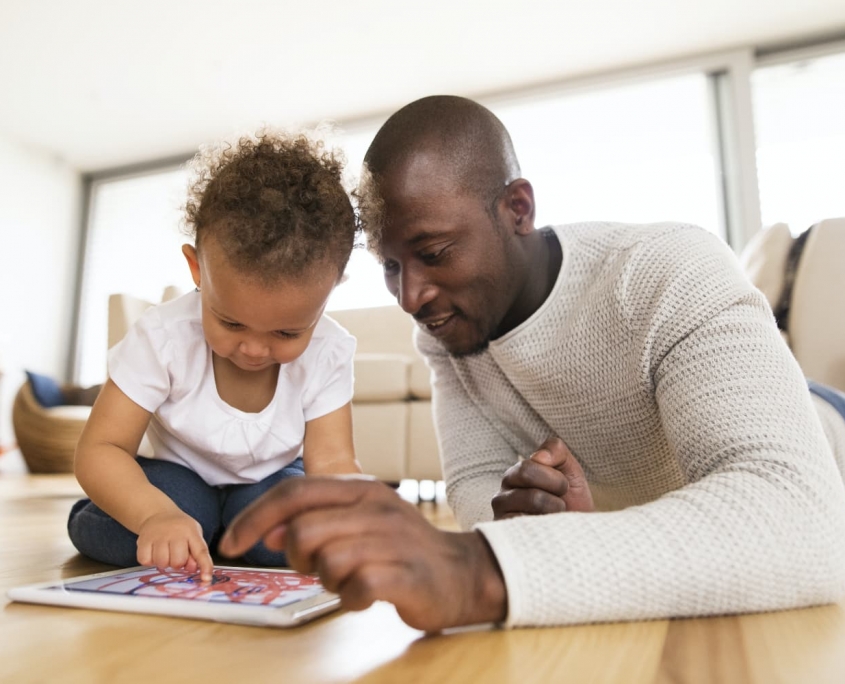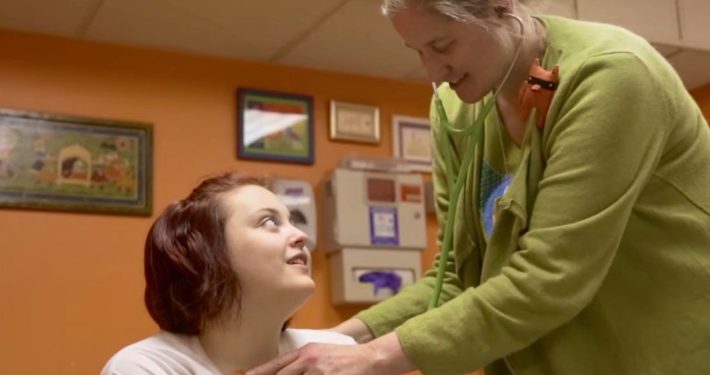Finding the Middle Way with Kids and Digital Media
The impacts of digital media use on children, both positive and negative, are increasingly visible as Generation Z comes of age. How do different types of media affect childhood brain development, and what can pediatricians do to help kids build healthy relationships with their screens?
The impacts of digital media use on children, both positive and negative, are increasingly visible as Generation Z comes of age. Families may battle a child’s obsession with television, social media, and video games; at the same time, tools for early learning and progressive education abound online. What are the risks and benefits of media use? How do different types of media affect childhood brain development, and what can physicians do to help kids build healthy relationships with their screens?
Kids and Digital Media
In caring for the whole child, pediatricians have seen an increasing need to address childhood media use. Clearly, the digital media landscape—including television and video media, social media, and video gaming—has evolved rapidly in the last two decades. Because of this fast-paced development over the past twenty years, the long-term effects of media use on brain development in children are still relatively unknown.
Data shows, however, that excessive use of media can be harmful to childhood and adolescent brain development. In particular, excessive usage may limit children’s abilities to build empathy, communication skills, and other social competencies. In a press release, University of California at Los Angeles (UCLA) Psychology Professor Patricia Greenfield stated, “Decreased sensitivity to emotional cues — losing the ability to understand the emotions of other people — is one of the costs [of digital media use]. The displacement of in-person social interaction by screen interaction seems to be reducing social skills.”
While these findings are troubling, it’s important to keep in mind that media use isn’t objectively “bad.” It would be naive, and downright unrealistic, to recommend that anyone living and working in 2020 should abstain from digital media use, as we use it for everything from paying bills to reading books. And, according to the AAP, there are some benefits for children using digital media: “Evidence-based benefits identified from the use of digital and social media include early learning, exposure to new ideas and knowledge, increased opportunities for social contact and support, and new opportunities to access health promotion messages and information.” Media can help us form connections, or access important information, that may be out of our reach otherwise.
Given these caveats, what do current research and guidelines say about media use? And what can pediatricians, parents, and educators do to support children in developing healthy habits with digital media?
“Most young people, and most adults, are drawn into the addictive digital world. It’s fast, it’s distracting, and it can be very informative. All populations need awareness around media use and its power over our brains, and thus our emotions.”Erin Tanner-Jospe
Media Use in Early Childhood
In 1999, the American Academy of Pediatrics’ (AAP’s) recommendations discouraged “any television viewing for children under the age of two years.” That recommendation is no longer realistic in an era where the term “digital babysitter” is in common parlance.
While previous generations may not have been exposed to digital media until adolescence or adulthood, most children born in the U.S. in the 2000s begin using digital media as toddlers, or even in infancy. At a restaurant, it’s not uncommon to see a child playing on their iPad while the adults share a meal. During the commute to school, kids are likely gaming, listening to music, or Snapchatting. “Screen time” is ubiquitous, and it’s convenient for parents with a lot on their plate. But what are the effects of this early life media use?
Some studies show an impact on brain development. JAMA Pediatrics reported that preschool age children who used screens for a greater amount of time daily than recommended by the AAP had lower development of brain white matter tracts, which support language and literacy skills. These children also scored lower on cognitive assessments. Recently, CBS published a piece on a National Institutes of Health (NIH) study concluding that kids who spend more than two hours a day on screens scored lower on thinking and language tests. As language and literacy are key to communication with others, a deficit in the brain’s white matter that supports these skills could manifest in antisocial or isolating behavior later in life.
Of course, practitioners in the field report these issues firsthand. Erin Tanner-Jospe is a licensed school counselor in Colorado, and holds her Masters in Movement Therapy from UCLA and in Counseling Psychology from Naropa University. She serves as a school counselor in Boulder, CO, for middle and high school-aged kids, teaching social-emotional health curricula and offering individual counseling. In her role, Tanner-Jospe often works with children and parents dealing with screen time issues. “Most young people, and most adults, are drawn into the addictive digital world,” she explains. “It’s fast, it’s distracting, and it can be very informative. All populations need awareness around media use and its power over our brains, and thus our emotions.”
However, Tanner-Jospe posits that elementary-middle school aged children need extra support managing screen time: “Younger kids whose brains are not fully developed yet, and naturally seek instant gratification and tools to build a sense of self, are most affected by digital media,” she says. “If they can develop healthy habits young, they are less likely to be addicted as teenagers.” Tanner-Jospe works in conjunctions with students’ mental health providers outside of school as well, to make sure they are supported off-campus.
Lessons from Television
A 2013 study in Pediatrics followed a cohort from birth to age 26 in New Zealand. Researchers found that, “young adults who had spent more time watching television during childhood and adolescence were significantly more likely to have a criminal conviction, a diagnosis of antisocial personality disorder, and more aggressive personality traits,” compared to those who viewed less television.
Although television is only one of the many media options available to consumers, its effects have been more consistently studied due to its longer lifespan. While imperfect, insights from television research may offer us some information about the effects of many types of media on childhood brain development. A 2007 study published in the Pediatrics found that, “many young children (one fifth of 0- to 2-year-olds and more than one third of 3- to 6-year-olds) have a television in their bedroom. The most common reason given was that it frees up other televisions in the house so that other family members can watch their own shows (54%).”
The conclusion here points to parents’ desire to consume television as well; thus, children’s TV consumption is correlated to parental habits (see section on guiding healthy media use below.) This finding highlights the importance of parents both role-modeling and guiding healthy media use. The report continues, “the majority of children aged 3 to 6 fell within the AAP’s media use guidelines, but 70% of 0- to 2-year-olds did not.”1 As this study is over a decade old, those 0-2 year olds are today’s adolescents and young adults.
Additionally, in a 2011 study the AAP found that “90% of parents report that their children younger than 2 years watch some form of electronic media. By 3 years, almost one-third of children have a television in their bedroom.” Not only are children consuming excess television; they have private access to these devices, watching in the isolation of their rooms where adults cannot monitor the amount of exposure or the content. Again, those media-consuming toddlers are today’s teens and young adults. By looking at today’s adolescents, we can observe how current behavior may reflect childhood media consumption.
Generation Z, Screens, and Mental Health
Early childhood media use sheds light on issues faced by today’s older children and adolescents (Gen Z), as this generation was raised with technology at their fingertips. Gen Z typically refers to people born after 1997, and has also been referred to as the iGeneration. Pew Research Center reports that “the implications of growing up in an ‘always on’ technological environment are only now coming into focus. Recent research has shown dramatic shifts in youth behaviors, attitudes and lifestyles – both positive and concerning – for those who came of age in this era.” One of these concerning elements is an increase in mental health problems. Anxiety and depression is on the rise for these young people, and screen time may be part of the problem.
27% of Gen Zers report their mental health as fair or poor, as compared to Millennials at 15%, according to an American Psychological Association (APA) report. A 2018 Pew Research poll revealed that today’s teenagers are “far less concerned about age-old teenage problems… than they are about mental health.” The poll found that 70% of respondents thought anxiety and depression were a major issue amongst their peers. However, the APA’s chief executive points out that this reportage could be, “an indicator that [Gen Zers] are more aware of and accepting of mental health issues,” than older generations. Tanner-Jospe corroborates the notion of Gen Zers’ forthrightness. “Compared to older generations, Gen Z communities are willing to talk about mental health, and don’t necessarily see counseling as taboo,” she says.
While there are myriad causes of poor mental health in adolescents, the rise of mental health issues correlates with the proliferation of screens and an increase in daily screen time usage per individual teenager in America, now averaging seven hours a day not including school or homework.2 There are various impacts of this exposure. The AAP paints the risks of digital media consumption for children and teens in broad strokes: “Risks of such media include negative health effects on sleep, attention, and learning; a higher incidence of obesity and depression; exposure to inaccurate, inappropriate, or unsafe content and contacts; and compromised privacy and confidentiality.” The downsides of excessive screen use can hit kids in their school, social, and home life.
Tanner-Jospe offers anecdotes of smartphone usage in her population, primary middle and high school students from upper-middle class families. “In 2019, I’ve seen a trend with middle schoolers aged 10-12 already having phones and access to apps such as Tik Tok and other chat or video chat apps,” she says. “On one hand, the kids use their phones for practical purposes, such as calling their parents to pick them up from school, keeping in touch with friends etc.”
What concerns Tanner-Jospe is the increased substitution of digital communication for verbal, face-to-face communication. “What I’ve become aware of is the increased social interaction primarily on screens,” she says. “Sometimes kids write comments and criticisms towards other kids—sometimes very damaging things—without thinking about the consequences of their words or who would or could see it. Oftentimes younger kids don’t have the education about social media use and its permanence on the internet before they begin using it on a regular basis.” This trend towards texting rather than talking makes it harder for kids to understand the impact of unkind language, as they are not privy to each other’s real life reactions.
Gaming: Risks and Rewards
Video games like Fornite and Grand Theft Auto have enjoyed incredible popularity, as well as a degree of infamy, amongst teens and parents. The Center on Media and Child Health (CMCH) reports that 66% of tweens aged 8 to 12 play video games for an average of two hours per day; 56% of teens ages 13 to 17 play video games for an average of 2.5 hours per day; and boys typically play more video games than girls. CMCH describes some of the key motivations for video game playing as allowing youth to escape their problems; to try on different personalities; to socialize; and to engage in challenging and reward-based experiences.3 Creating non-gaming experiences that give these same rewards—such as playdates or athletic activities—could mitigate excessive gaming.
In 2014, the journal Cyberpsychology, Behavior & Social Networking reported that, “studies have found that high exposure to both violence and violent events is associated with increased levels of depression among children and adolescents.” Further, researchers found that students who reported problematic video gaming were more than three times as likely to report being depressed as their moderate or non-gamer peers. Problematic gaming was defined by those who reported “impulse-control symptoms” related to gaming. In other words, they had trouble controlling when they started or stopped a gaming session.4
As exposure to violent images is linked to depression, and since many video games contain violent imagery, these exposures can compound in young patients to increase their risk of depression. While these findings indicate a link between depression and gaming, the study points out that most current research focuses on the relationship between gaming and aggression, not gaming and depression; therefore, there is a dearth of studies that corroborate these findings. Aggression, also coded as emotional desensitization, in this case refers to a gamer’s ability to access feelings like empathy or fear when faced with “emotional images.” A study in the Journal of Applied Social Psychology found that college-aged gamers who played violent video games had lowered feelings of “pleasure and displeasure toward emotional stimuli.”5 Other risks of gaming include cyberbullying, sexual harassment, anxiety, sleep problems, and obesity.6
“Screen time has become an obsolete concept in an era where we are surrounded by screens and move seamlessly between the digital and the physical… It is how we choose to use screens and to pursue non-screen activities, it is the content we consume on screens and the contexts in which we consume it, that affects our well-being.”Dr. Michael Rich
Guiding Healthy Media Use
Independent pediatricians can play an important role in supporting children and families in having open conversations about media use, as well as reducing their screen time. One of pediatricians’ most effective actions to mitigate unhealthy media use is to support parents in creating screen time parameters with their children.
In 2016, the AAP released a statement focused on infants, toddlers, and pre-school children’s media consumption. “Families should proactively think about their children’s media use and talk with children about it, because too much media use can mean that children don’t have enough time during the day to play, study, talk, or sleep… What’s most important is that parents be their child’s ‘media mentor.’ That means teaching them how to use it as a tool to create, connect and learn.”
Thus, the AAP recommends that pediatricians work with parents first and foremost to help them become these “media mentors.” Pediatricians can recommend that families use the AAP’s Family Media Plan resource, which allows families to create a personalized media plan based on their unique parenting style and needs. This resource offers some dexterity based on families’ differing work schedules and childcare options.
In her experience as a school counselor, Tanner-Jospe agrees that parental involvement and education are key, alongside the efforts of teachers and pediatricians. “I don’t advocate looking at your kid’s phone without permission, but parents can develop a sense of what’s out there, staying current and having real conversations with your kids.” She continues, “I believe in the middle path with screen use, such as teaching moderation, and educating kids about the impact of their words and actions online. Kids and adults can easily procrastinate and avoid hard feelings or conversations by numbing with media use. I believe that we need to teach kids to be in touch with their more uncomfortable emotions, to grow their tolerance for these feelings. That way they won’t feel the need to ‘hide’ as much in their phones and games.”
Fighting against kids’ gaming and media habits can feel like fighting against a rip tide. Families may need additional tools, in conjunction with pediatric intervention. What might be some lasting antidotes to tech addictions? Although harder to access for under-resourced communities, modalities like counseling, mindfulness techniques, and immersion in nature can create tech-free spaces that teach kids the value of turning off their phone. Progressive education models, like wilderness school Kroka Expeditions, identify the need to allow students to, “take healthy physical and social risk,” (one of the motivating factors for gaming) by living simply “without excessive technology.”7
On these programs, students from ages nine and up spend weeks or months without smartphones, and with extremely limited access to computers, as they travel in the wilderness. An instructor at a similar program, High Mountain Institute, speaks to the power of technology detoxes: “At the end of the semester, students say going without their phone was one of the most meaningful parts of their experience. They’re able to bond with peers and really be present when they don’t have the ‘safety net’ of looking at SnapChat, for example.” In the previously cited UCLA report, researchers studied sixth-graders at a nature and science camp who went without any technology for five days; they saw significant improvement in children’s ability to “read facial emotions and other nonverbal cues to emotion, compared with students who continued to use their media devices.”
Informed voices in children’s health recommend intention and moderation. Dr. Michael Rich, Director of CMCH at Boston Children’s Hospital, writes in a blog post that “screen time has become an obsolete concept in an era where we are surrounded by screens and move seamlessly between the digital and the physical… It is how we choose to use screens and to pursue non-screen activities, it is the content we consume on screens and the contexts in which we consume it, that affects our well-being.” Screen time is inevitable for both children and adults, and demonizing it may actually work against our desired outcomes: fostering the growth of happy, healthy, and whole children, and eventually, adults.
[1] Vandewater, Elizabeth A, Victoria J Rideout, Digital Childhood: Electronic Media Technology Use Among Infants, Toddlers, and Preschoolers ↑
[2] https://www.commonsensemedia.org/research/the-common-sense-census-media-use-by-tweens-and-teens-2019 ↑
[3] https://cmch.tv/parents/video-games/ ↑
[4] NCBI. Daily Violent Video Game Playing and Depression in Preadolescent Youth. Sept 2014. https://www.ncbi.nlm.nih.gov/pmc/articles/PMC4227415/ ↑
[5] Patricia Arriaga, Maria Benedicta Monteiro and Francisco Esteves, Effects of Playing Violent Computer Games on Emotional Desensitization and Aggressive Behavior. Journal of Applied Social Psychology. Aug 2011. ↑
[6] Center on Media and Child Health, Video Games: Risks. Boston Children’s Hospital. 2019. https://cmch.tv/parents/video-games/ ↑
[7] Kroka Curriculum. https://www.kroka.org/the-kroka-curriculum/. Accessed January 30, 2020. ↑
Emily Graf is a freelance writer, wilderness educator, and English teacher living in Colorado. She is passionate about telling stories that promote equal access to quality health care. She can be contacted at emgraf11@gmail.com for inquiries.









